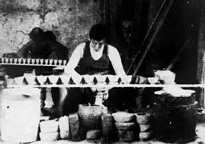(翻译:德化窑遗产文化研究院 孙延燕)
编者按:瓷器的工业化最早从中国开始,因此,对于早期的西方人来说,瓷器就是他们向往的诗和远方。
然而,当时真正来过中国的西方人并不多。1935年5月,西方学者萨顿(Willard James Sutton)到德化瓷厂参观,英国作家唐纳利撰写的《中国白—福建德化瓷》(《Blanc de Chine -Porcelain of Tehua in Fukien》)一书记录了他当时的见闻。
千年不断的窑火成就了德化这样一座特殊的城市,古老的匣钵及陶瓷碎片静静地述说时代的更迭。瓷都的时间似乎过得很快,发展日新月异;瓷都的时间似乎又过得很慢,古老的烧窑和陶瓷制作方式如今在此仍依稀可见,韵味隽永。

Wares so decorated were still cheap-a twelve-piece tea set with decoration to order and with a tray bearing an inscription commemorating the visit of the Sutton party was ready in two days at a price of two shillings. Gold ornament was freely used.When a kiln isin use for a long time broken seggars and pottery so clutter up the place that a new site is chosen in preference to clearing away the rubble.That is why abandoned kiln sites are to be found in and near scores of villages of a pottery making centre, and Sutton tells us that the pre-war road building programme in Tehua district revealed hundreds of these. He particularly mentions one with a tree growing over it having a trunk 14 ft.in circumference, and the 1960 investigators made a similar discovery.
这样装饰仍然很便宜——一套十二件套的茶具,上面有装饰,还有一个托盘,上面刻有萨顿一行人来访的铭文,两天后就准备好了,售价两先令。黄金装饰方法被随意使用。当一个窑使用了很长一段时间,破碎的匣钵和陶器会随意丢弃,以至于人们宁愿选择一个新的地点也不愿意清理这些瓦砾。这就是为什么在一个陶器制造中心的几十个村庄及其附近会发现废弃的窑场,萨顿告诉我们,战前在德化的道路建设发现了数百个这样的地方。他特别提到一个窑址,旁边有一棵周长约14英尺的树,1960年的调查人员也有类似的发现。
